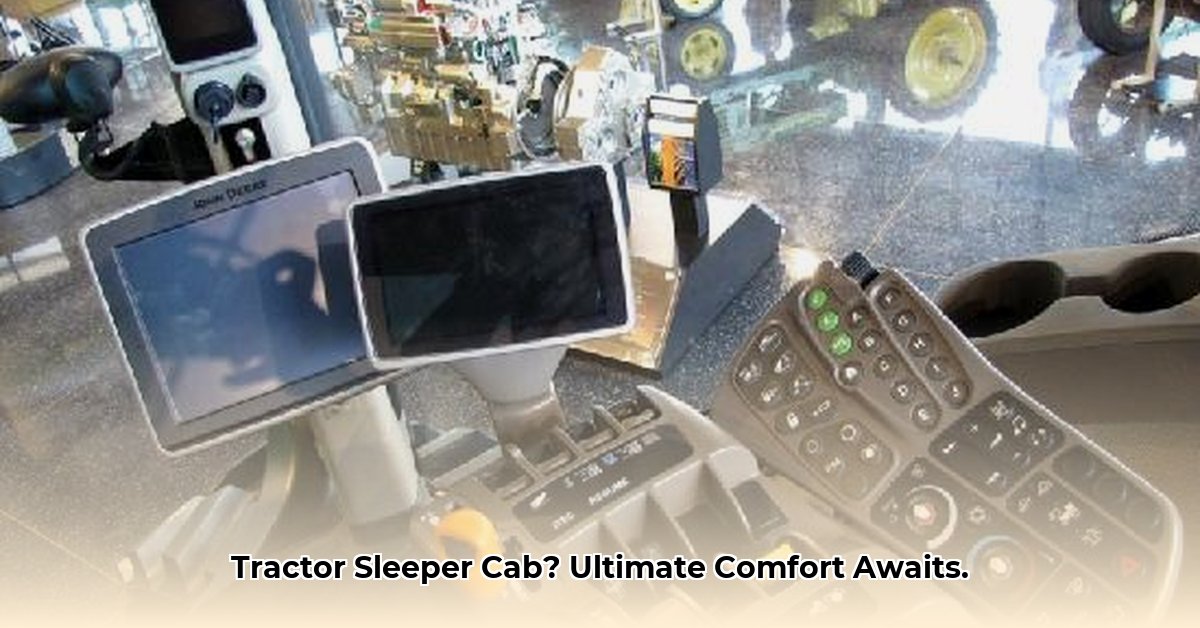
Stepping into a trucker's sleeper cab is like entering a unique world – a tiny apartment on wheels. These cabs aren't just places to sleep; they're offices, personal spaces, and sometimes, escapes from the road. But with diverse designs, choosing the right one requires understanding the available options and their impact on comfort, safety, and even business profitability. This guide explores various sleeper cab types, offers tips for maximizing space, and helps you make informed decisions, whether you're a seasoned driver or a prospective truck buyer. For more detailed specifications, check out this helpful resource on truck sleeper cabs.
Basic Sleeper Cab: Function Over Frills
The basic sleeper cab prioritizes functionality over luxury. Think of it as a compact studio apartment – enough room for a bed and minimal storage. It's perfect for short hauls and commonly provided by trucking companies. While practical, long journeys may leave drivers craving more space and amenities.
Pros:
- Low cost: An economical choice.
- Readily available: Easily found in most fleets.
Cons:
- Limited space: Minimal storage necessitates light packing.
- Minimal amenities: Expect basic functionality, not comfort.
- Discomfort on long hauls: Extended trips can be challenging.
Mid-Range Sleeper Cab: The Balanced Approach
The mid-range sleeper cab offers a significant upgrade. Imagine a cozy one-bedroom apartment – more storage, a larger, more comfortable mattress, and potentially added features like shelves, a small refrigerator, and a microwave. It balances comfort and affordability, making it popular among many drivers.
Pros:
- Improved comfort: Enhanced sleeping space and overall living area.
- Increased storage: Room for essentials and personal items.
- Added convenience: Inclusion of small appliances improves daily life.
Cons:
- Lacks major luxury features: No large refrigerators or entertainment systems.
- Space limitations persist: Still a relatively small living space.
Luxury Sleeper Cab: Mobile Home Away From Home
A luxury sleeper cab transforms your truck into a mobile apartment – a small, well-appointed space with home-like comforts. These may include high-end amenities such as flat-screen TVs, full-sized refrigerators, microwaves, and even a small bathroom. Premium materials like leather are common. Owner-operators often opt for this upgrade to enhance their quality of life on the road. However, the significant initial investment and ongoing maintenance costs are key considerations.
Pros:
- Maximum comfort: A personal mobile oasis.
- Home-like amenities: Maximum convenience and comfort on the road.
- Improved well-being: Increased comfort translates to better sleep and health.
Cons:
- High initial cost: A substantial upfront investment.
- Increased maintenance: More features mean more potential repairs.
- Potential fuel consumption concerns: Additional features may impact fuel efficiency.
Choosing the Right Sleeper Cab: A Guide for Drivers and Buyers
The ideal sleeper cab depends on individual needs and priorities. Let's consider various user groups:
Company Drivers: Your company likely provides the cab. Focus on maximizing comfort with additions like comfortable pillows and organizational tools. Maintaining a clean, organized space is crucial.
Owner-Operators: Carefully weigh features, costs, and long-term maintenance expenses. Research financing options and consider how features might impact fuel economy. A realistic budget is essential.
Truck Buyers: Compare specifications and features across manufacturers. The lowest price isn't always the best value; consider long-term ownership costs.
The Future of Sleeper Cab Design
The trucking industry continues to evolve, and sleeper cab design will follow. Anticipated future improvements include enhanced fuel efficiency, better technology integration (smarter climate control, entertainment systems), the use of sustainable materials, and aerodynamic refinements. Expect increased focus on driver comfort and well-being through technological integration.
Areas for Further Research
While this guide offers a thorough overview, further research is needed to quantify certain aspects. Studies on cost differences between cab configurations, the impact of features on fuel efficiency, and the real-world effects of amenities like onboard bathrooms would provide valuable data for drivers and transportation companies. These knowledge gaps highlight areas for future investigation.
How to Maximize Comfort and Efficiency in Your Sleeper Cab
Key Considerations:
- Larger cabs generally offer more comfort but may reduce fuel efficiency.
- Prioritize essential features like mattress quality, storage, and climate control.
- Carefully evaluate long-term ownership costs and financing options.
- Customization impacts both cost and comfort levels.
- Research and compare various manufacturers' offerings.
Sleeper Cab Sizes: Finding the Right Fit
Cab size directly correlates with comfort. Basic sleepers offer functionality, while mid-range models provide more space and amenities. Luxury cabs provide spaciousness but at a premium. Consider the impact of increased weight on fuel efficiency. The ideal size depends on your needs and budget.
Essential Features: Prioritizing Your Needs
What matters most to you? Prioritize based on your needs and preferences. A comfortable mattress, ample storage, a powerful climate control system, multiple power outlets, and safety features (e.g., emergency lighting and security systems) are all important considerations.
Choosing a Cab: Owner-Operator vs. Company Driver
Owner-operators enjoy extensive customization options, but this increases initial costs and long-term maintenance. Company drivers typically have limited choices, working with employer-provided cabs. Understanding the features of each is vital for both groups.
The Impact of Customization: Weighing the Pros and Cons
Customization enhances comfort and functionality, but adds to initial cost, weight, and potential fuel consumption. Weigh the return on investment carefully before adding numerous custom options.
Fuel Efficiency: A Crucial Factor
While data on fuel efficiency comparisons across different cab models remains scarce, this is a critical area for investigation. Several factors, including size, weight, driving habits, and terrain, influence fuel use. More research is necessary.